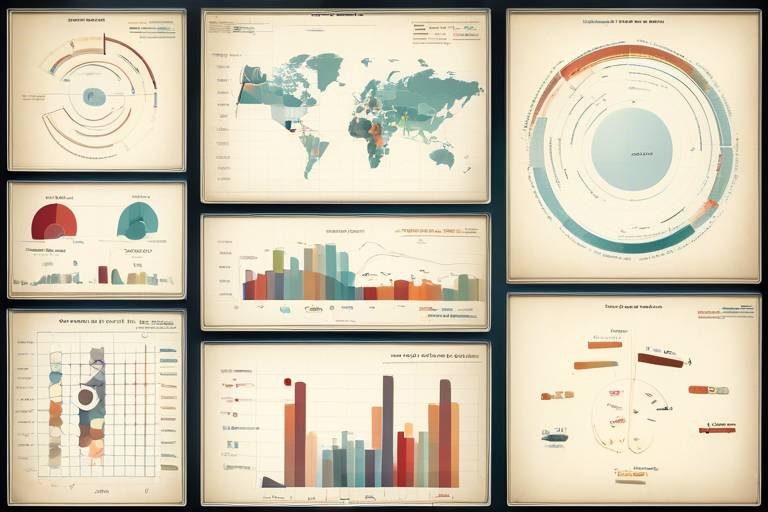Understanding Price Action Trading Techniques
Price action trading is like peeling an onion; the more you delve into it, the more layers you uncover. This article explores various price action trading techniques, offering insights into their effectiveness and application in different market conditions for traders seeking to enhance their strategies. Unlike traditional trading methods that often rely heavily on indicators and complex algorithms, price action trading is rooted in the very essence of market movement—price itself. By focusing on historical price movements, traders can make informed decisions that reflect the current state of the market.
Imagine standing on the sidelines of a busy street, observing the ebb and flow of traffic. Each car represents a trader making decisions based on the signals they receive—some stop, some go, and others take a detour. In price action trading, you become that observer, analyzing how price behaves over time. This method allows traders to identify trends, reversals, and potential entry and exit points, all through the lens of price movements. It's a straightforward approach that strips away the noise of indicators, allowing traders to connect more deeply with market dynamics.
One of the most compelling aspects of price action trading is its adaptability. Whether you're navigating a volatile market or a steady trend, the principles of price action remain relevant. Traders can apply these techniques across various asset classes, including stocks, forex, and commodities. This versatility is what makes price action trading an invaluable tool in a trader's arsenal.
In essence, mastering price action trading techniques is not just about understanding charts; it's about developing a keen sense of market intuition. As you become more attuned to price movements, you'll find that your ability to anticipate market behavior improves significantly. So, buckle up and get ready to explore the fascinating world of price action trading—it could very well be the key to unlocking your trading potential!
- What is price action trading? Price action trading focuses on historical price movements to make trading decisions, emphasizing chart analysis over indicators.
- Why is price action trading effective? It provides a clear understanding of market behavior, allowing traders to identify trends and reversals without the clutter of indicators.
- Can price action trading be used in any market? Yes, price action trading techniques can be applied across various asset classes, including stocks, forex, and commodities.
- What are some common price patterns? Common price patterns include flags, triangles, and head and shoulders, which help traders predict future price movements.

What is Price Action Trading?
Price action trading is a methodology that focuses on the historical movements of asset prices to guide trading decisions. Unlike traditional trading strategies that rely heavily on indicators, such as moving averages or oscillators, price action trading emphasizes the raw price data itself. This approach allows traders to interpret market behavior through the lens of price movements, making it a straightforward yet powerful technique for navigating the complexities of the financial markets.
At its core, price action trading is about understanding the story that price tells. Imagine watching a movie without sound; you would rely on the visuals to understand the plot. Similarly, in price action trading, traders analyze charts and patterns to decipher market sentiment and potential future movements. This method can be particularly effective in various market conditions, whether trending or ranging.
One of the most appealing aspects of price action trading is its simplicity. By stripping away the noise of indicators, traders can focus on what really matters: the price itself. This clarity can lead to more confident trading decisions and ultimately better results. For instance, rather than getting bogged down in complex indicator signals, a price action trader might observe a breakout above a significant resistance level and decide to enter a long position based on that movement.
In practice, price action trading involves a few key components:
- Charts: Traders use various types of charts, such as line charts, bar charts, or candlestick charts, to visualize price movements.
- Patterns: Recognizing patterns such as flags, triangles, and head and shoulders can provide insights into market sentiment.
- Market Context: Understanding the broader market context, including economic news and events, can enhance the effectiveness of price action strategies.
By honing in on these elements, traders can develop a keen sense of market dynamics and improve their trading performance. Whether you are a novice looking to start your trading journey or an experienced trader seeking to refine your strategies, understanding price action trading can be a game-changer. It offers a unique perspective on market behavior that can empower you to make more informed decisions and capitalize on trading opportunities.

Key Principles of Price Action Trading
Understanding the foundational principles of price action trading is crucial for anyone looking to navigate the often turbulent waters of the financial markets. Price action trading is not just about reading numbers on a screen; it's about interpreting the story behind those numbers. This approach relies heavily on analyzing historical price movements and recognizing patterns that can indicate future behavior. By grasping these key principles, traders can develop strategies that align with prevailing market trends and anticipate reversals with greater accuracy.
One of the core tenets of price action trading is the identification of support and resistance levels. These levels serve as psychological barriers where buying and selling pressures converge. Support levels are like a safety net for prices, where buyers step in to prevent further declines, while resistance levels act as ceilings, where sellers emerge to push prices back down. Recognizing these levels can significantly enhance a trader's ability to pinpoint potential entry and exit points in their trades.
Moreover, price patterns play a vital role in price action trading. Patterns such as flags, triangles, and head and shoulders are not just random shapes; they carry significant meaning and can provide insights into market sentiment. For instance, a head and shoulders pattern often indicates a reversal, while a flag pattern can suggest a continuation of the current trend. By learning to recognize these patterns, traders can better predict future price movements and position themselves advantageously in the market.
Another essential principle is the importance of candlestick analysis. Candlestick charts are more than just a visual representation of price movements; they encapsulate market sentiment and trader psychology. Each candlestick tells a story—its color, size, and position relative to previous candles can reveal whether buyers or sellers are in control. By mastering candlestick patterns, traders can gain a deeper understanding of market dynamics and make more informed decisions.
Finally, combining candlestick analysis with price action principles offers a holistic view of market behavior. This integration allows traders to refine their strategies, enhancing their ability to react to changing market conditions. For instance, if a trader identifies a bullish candlestick pattern at a support level, they may consider this a strong signal to enter a long position. Conversely, a bearish pattern at a resistance level might prompt them to consider shorting the asset.
In summary, the key principles of price action trading revolve around the understanding of support and resistance levels, recognition of price patterns, and the interpretation of candlestick charts. By mastering these elements, traders can develop a robust framework for making informed trading decisions that resonate with market realities.
- What is price action trading? Price action trading focuses on analyzing historical price movements to make trading decisions without relying heavily on indicators.
- Why are support and resistance levels important? They help traders identify potential entry and exit points by indicating where buying and selling pressures may change.
- How do candlestick patterns impact trading decisions? Candlestick patterns can signal potential market reversals or continuations, aiding traders in making timely decisions.
- Can price action trading be used in all market conditions? Yes, price action trading techniques can be applied across various market conditions, making them versatile for different trading environments.

Support and Resistance Levels
Support and resistance levels are the backbone of price action trading. They serve as crucial indicators that help traders understand where the market is likely to move next. Think of these levels as invisible barriers that can either hold or repel price movements. When a price reaches a support level, it often bounces back up, as buyers step in to purchase the asset. Conversely, at resistance levels, sellers typically emerge, pushing the price back down. Understanding these concepts is essential for any trader looking to enhance their strategies.
To effectively identify support and resistance levels, traders often rely on historical price data. These levels are not just random; they are formed by the collective actions of market participants. For example, if a stock has repeatedly bounced off a certain price point, that price becomes a significant support level. On the flip side, if the stock has failed to break above a specific price multiple times, that price point is recognized as a resistance level.
In practice, support and resistance levels can be identified using various methods, such as:
- Historical Data: Looking at past price movements to find where reversals have occurred.
- Trend Lines: Drawing lines on a chart to connect highs or lows can help visualize these levels.
- Moving Averages: These can act as dynamic support and resistance levels, adjusting as the price changes.
Moreover, the significance of these levels can vary. Some levels may be stronger than others, and this strength often depends on the number of times the price has tested them. The more times a price level has been tested without being broken, the more significant it becomes. This is akin to a sturdy dam that holds back water; the more pressure it withstands, the more confidence traders have in its strength.
It's also important to note that support and resistance levels can change over time. A level that once acted as support can turn into resistance if the price breaks below it, and vice versa. This phenomenon is known as a "flip" and is a critical concept for traders to grasp. By staying adaptable and continuously analyzing market movements, traders can refine their strategies and make informed decisions based on these dynamic levels.
In conclusion, mastering support and resistance levels is fundamental for anyone engaged in price action trading. These levels provide a roadmap for potential entry and exit points, enabling traders to navigate the market with greater confidence. By understanding how to identify and interpret these levels, traders can improve their chances of success in an ever-changing market landscape.
- What are support and resistance levels? Support and resistance levels are price points on a chart where buying and selling pressure tends to emerge, influencing market movements.
- How can I identify support and resistance levels? You can identify these levels through historical data analysis, trend lines, and moving averages.
- Why are support and resistance levels important? They help traders determine potential entry and exit points, enhancing their trading strategies.
- Can support become resistance and vice versa? Yes, when a price breaks through a support level, it can become resistance, and vice versa.

Identifying Support Levels
Identifying support levels is a fundamental aspect of price action trading that can significantly enhance a trader's decision-making process. Support levels are price points where buying interest tends to outweigh selling pressure, resulting in a price rebound. Think of these levels as a safety net for prices; when they fall to this point, buyers swoop in, creating a cushion that prevents further declines. But how do you pinpoint these crucial levels? Let's break it down.
To effectively identify support levels, traders often look for historical price points where the asset has previously bounced back. This requires a keen eye on the charts. Here are some strategies to consider:
- Historical Price Points: Examine past price movements on the chart. If a price has bounced back multiple times from a certain level, it's likely to act as a support level in the future.
- Volume Analysis: Look for spikes in trading volume at specific price levels. High volume at a price point indicates strong buying interest, reinforcing the idea of support.
- Moving Averages: Utilize moving averages as dynamic support levels. For example, the 50-day or 200-day moving averages often serve as reliable support zones.
It's also important to consider the context of the market when identifying support levels. For instance, in a strong bullish trend, support levels may be higher than previous lows, reflecting increasing buying interest. Conversely, in a bearish market, traders should remain cautious as support levels can be broken more easily.
Another effective method to identify support levels is through the use of trend lines. Drawing a trend line along the lows of a price movement can help visualize potential support. If the price approaches this line and bounces back, it further confirms the strength of that support level. Additionally, traders can look for chart patterns that indicate potential support, such as double bottoms or rounded bottoms, which often signal a reversal.
Ultimately, the key to successfully identifying support levels lies in practice and experience. The more you analyze charts and apply these techniques, the more intuitive it becomes. Remember, support levels are not set in stone; they can change with market dynamics. Therefore, it's essential to remain flexible and adapt your strategies accordingly.
- What is the difference between support and resistance levels? Support levels are price points where buying interest is strong enough to prevent the price from falling further, while resistance levels are where selling pressure is strong enough to stop the price from rising.
- How can I confirm a support level? You can confirm a support level by observing price action, volume spikes, and the presence of trend lines. If the price bounces back multiple times from a level, it reinforces that level as a support.
- Can support levels change over time? Yes, support levels can change based on market dynamics and trader behavior. It's important to continually reassess these levels as new price data comes in.

Identifying Resistance Levels
Identifying resistance levels is a fundamental aspect of price action trading that can significantly enhance a trader's decision-making process. Resistance levels are price points where selling pressure tends to emerge, causing the price to stall or reverse. Understanding where these levels lie can help traders make informed choices about when to enter or exit trades. Think of resistance levels as the ceiling in a room; just as a ceiling limits how high you can go, these levels can limit how far prices can rise before facing selling pressure.
To effectively identify resistance levels, traders often analyze historical price data and look for areas where the price has previously struggled to rise above. Here are some key strategies to help pinpoint these critical levels:
- Historical Highs: Look for previous peaks in the price chart. If the price has failed to break above a certain level multiple times in the past, it is likely to act as a resistance level in the future.
- Psychological Levels: Round numbers, such as 100, 200, or 1000, often serve as psychological barriers where traders might place sell orders, creating resistance.
- Technical Indicators: Utilize moving averages, Fibonacci retracement levels, or trend lines, which can also act as dynamic resistance levels. For instance, a 50-day moving average may serve as a resistance point when the price approaches it from below.
Once you identify potential resistance levels, it's essential to monitor how the price behaves as it approaches these areas. A common phenomenon is the rejection of price at these levels, where the price touches the resistance and then quickly retreats. This can be a signal for traders to consider selling or setting up short positions. Conversely, if the price breaks through a resistance level decisively, it may indicate a strong bullish trend, prompting traders to re-evaluate their strategies.
In summary, recognizing resistance levels is not just about identifying a point on a chart; it's about understanding market psychology and the dynamics of supply and demand. By honing your skills in identifying these levels, you can gain a competitive edge in your trading endeavors.

Price Patterns and Their Significance
Price patterns are like the fingerprints of the market; they tell a story about the collective behavior of traders and investors. Just as a detective examines clues to solve a mystery, traders analyze these patterns to predict future price movements. Recognizing these patterns can significantly enhance a trader's ability to make informed decisions. They often serve as indicators of market sentiment, revealing whether traders are feeling bullish (optimistic) or bearish (pessimistic).
Among the most common price patterns, we find formations like flags, triangles, and head and shoulders. Each of these patterns has its own significance and can provide valuable insights into potential market movements:
- Flags: These are continuation patterns that suggest a brief consolidation before the previous trend resumes. They often appear after a strong price movement.
- Triangles: Triangles can be ascending, descending, or symmetrical, and they indicate a period of indecision in the market. Traders often look for breakouts from these formations to determine the next significant movement.
- Head and Shoulders: This pattern signals a potential reversal in trend. It consists of three peaks: a higher peak (head) between two lower peaks (shoulders). Recognizing this pattern early can lead to profitable trading opportunities.
Understanding these patterns is crucial for traders, as they act as visual cues that can help in making strategic decisions. For instance, when a trader identifies a head and shoulders pattern, they might consider it a signal to prepare for a potential downtrend, allowing them to position themselves accordingly. Conversely, spotting a flag pattern might encourage them to stay in their trade, anticipating a continuation of the upward movement.
Moreover, the significance of price patterns extends beyond mere recognition. They also help traders to set risk management strategies. For example, knowing where a pattern typically leads can assist in placing stop-loss orders effectively, minimizing potential losses. In essence, mastering price patterns is akin to learning the language of the market; it empowers traders to respond more adeptly to changing conditions.
In conclusion, price patterns are not just shapes on a chart; they are vital tools that can help traders navigate the complexities of the financial markets. By becoming proficient in identifying and interpreting these patterns, traders can enhance their trading strategies and improve their chances of success.
1. What are price patterns?
Price patterns are formations created by the price movements of an asset on a chart. They help traders identify potential future movements based on historical behavior.
2. Why are price patterns important in trading?
They provide insights into market sentiment and can indicate potential reversals or continuations, allowing traders to make informed decisions.
3. How can I identify price patterns?
Traders can identify price patterns by analyzing charts and looking for specific formations, like flags, triangles, and head and shoulders.
4. Can price patterns guarantee success in trading?
While price patterns can enhance decision-making, they do not guarantee success. It's essential to combine them with other analysis tools and risk management strategies.

Reading Candlestick Charts
Candlestick charts are like the heartbeat of the trading world, pulsating with the rhythm of market activity. These charts provide an incredibly visual representation of price movements over a specific period, making it easier for traders to grasp market sentiment at a glance. Each candlestick tells a story, revealing the open, high, low, and close prices within that time frame. By analyzing these candlesticks, traders can uncover trends and potential reversals, which are crucial for making informed trading decisions.
To truly understand candlestick charts, one must familiarize themselves with the different types of candlestick patterns. These patterns can signal various market conditions, helping traders anticipate future price movements. For instance, a bullish engulfing pattern indicates a potential price increase, while a bearish engulfing pattern suggests a possible decline. Recognizing these patterns is essential for traders looking to capitalize on market fluctuations.
Moreover, the color of the candlestick plays a significant role in interpreting market sentiment. A green (or white) candlestick signifies that the closing price was higher than the opening price, indicating buying pressure. Conversely, a red (or black) candlestick indicates that the closing price was lower than the opening price, suggesting selling pressure. Understanding these color codes helps traders gauge whether the market is leaning towards bullish or bearish sentiment.
Another vital aspect of reading candlestick charts is recognizing the significance of the candlestick's body and wicks. The body represents the price range between the open and close, while the wicks (or shadows) show the high and low prices during that period. A long body indicates strong buying or selling pressure, while short bodies suggest indecision among traders. For example, if a candlestick has long wicks with a small body, it may indicate that the market is experiencing volatility, with traders struggling to establish a clear direction.
To illustrate the different components of a candlestick, here's a simple table that breaks down the elements:
| Component | Description |
|---|---|
| Body | The range between the opening and closing prices. |
| Wick (Shadow) | The lines extending from the body, indicating the highest and lowest prices during the period. |
| Open Price | The price at which the asset opened for that period. |
| Close Price | The price at which the asset closed for that period. |
Incorporating candlestick analysis into your price action trading strategy can significantly enhance your decision-making process. By observing candlestick formations in conjunction with price action principles, traders can refine their strategies and improve their overall trading performance. For instance, if a trader notices a bullish candlestick pattern forming at a support level, it could be a strong signal to enter a long position. On the flip side, a bearish pattern at a resistance level may prompt a trader to consider shorting the asset.
In summary, mastering the art of reading candlestick charts is a game-changer for traders. It empowers them to interpret market dynamics effectively and make timely decisions that align with their trading strategies. So, the next time you glance at a candlestick chart, remember that each candlestick is not just a number; it's a piece of the market's ever-evolving puzzle.

Understanding Candlestick Patterns
Candlestick patterns are like the secret language of the market, whispering insights about potential price movements. When you look at a candlestick chart, you’re not just seeing a bunch of colorful bars; you’re witnessing the battle between buyers and sellers unfold. Each candlestick represents a specific time frame and encapsulates the open, high, low, and close prices, giving you a snapshot of market sentiment. But what makes these patterns truly fascinating is their ability to signal potential reversals or continuations in price trends.
To truly grasp the significance of candlestick patterns, it’s essential to recognize some of the most common formations. For instance, a Doji indicates indecision in the market, where the opening and closing prices are virtually the same. This often suggests that a reversal could be on the horizon, as buyers and sellers are at a stalemate. On the other hand, a Hammer pattern, which appears at the bottom of a downtrend, can signify a bullish reversal, hinting that buyers are starting to take control. Understanding these patterns is like having a roadmap that guides you through the twists and turns of the market.
Here’s a quick overview of some key candlestick patterns and their implications:
| Pattern | Type | Implication |
|---|---|---|
| Doji | Reversal | Indecision in the market |
| Hammer | Reversal | Bullish reversal signal |
| Engulfing | Reversal | Strong reversal signal |
| Morning Star | Reversal | Potential bullish reversal |
| Evening Star | Reversal | Potential bearish reversal |
Moreover, the context in which these patterns appear is just as crucial. A candlestick pattern that forms at a significant support or resistance level carries more weight than one that appears in the middle of a trend. This is where the synergy between candlestick patterns and price action trading comes into play. By combining these visual cues with an understanding of market structure, traders can make more informed decisions and enhance their trading strategies.
In summary, mastering candlestick patterns is a vital skill for any trader looking to navigate the complexities of the market. They provide valuable insights into market psychology, allowing traders to anticipate potential price movements. By paying attention to these patterns and their context, you can significantly improve your chances of making profitable trades. So the next time you glance at a candlestick chart, remember that each pattern is a story waiting to be told, and it might just lead you to your next big trading opportunity!
- What is a candlestick pattern? A candlestick pattern is a formation created by one or more candlesticks on a price chart that indicates potential market behavior.
- How do I identify candlestick patterns? You can identify candlestick patterns by looking for specific formations, such as Doji, Hammer, or Engulfing, and analyzing their context within the market.
- Why are candlestick patterns important? They provide insights into market sentiment and potential price movements, helping traders make informed decisions.
- Can I rely solely on candlestick patterns for trading? While they are valuable tools, it's best to combine candlestick analysis with other trading strategies and market analysis for optimal results.

Combining Candlestick Analysis with Price Action
Combining candlestick analysis with price action trading is like pairing a fine wine with a gourmet meal; it enhances the overall experience and leads to better outcomes. This integration allows traders to grasp the nuances of market movements more effectively. While price action focuses on historical price movements, candlestick charts provide a visual representation of that data, offering insights into market sentiment and potential future movements.
When traders analyze candlestick patterns alongside price action, they gain a comprehensive view of market dynamics. For instance, a single candlestick can convey a wealth of information, such as the opening and closing prices, as well as the high and low within a specific timeframe. By observing how these candlesticks form around significant support and resistance levels, traders can refine their strategies and make more informed decisions.
Imagine you’re a detective piecing together clues. Each candlestick is a clue that, when combined with the broader price action context, tells a story about the market's behavior. For example, if you see a bullish engulfing pattern forming at a support level, it’s a strong indication that buyers are stepping in, and the price may rise. Conversely, a bearish engulfing pattern at a resistance level could signal that sellers are gaining control.
To effectively combine these two approaches, traders should focus on several key aspects:
- Timeframes: Different candlestick patterns may have varying implications depending on the timeframe being analyzed. A pattern on a daily chart may carry more weight than one on a 5-minute chart.
- Volume Analysis: Observing volume alongside candlestick patterns can provide additional confirmation. High volume during a breakout from a pattern often indicates stronger conviction from traders.
- Market Context: Always consider the broader market context. Is the market trending or ranging? Understanding the larger picture can help in interpreting candlestick signals more accurately.
In summary, the synergy between candlestick analysis and price action trading creates a powerful toolkit for traders. By understanding how to read candlestick patterns and integrating them with price action principles, traders can enhance their ability to predict market movements. This combination not only improves the accuracy of trading decisions but also builds confidence in navigating the often unpredictable financial markets.
Q1: What is the main advantage of combining candlestick analysis with price action?
A: The main advantage is that it provides a more comprehensive understanding of market dynamics, allowing traders to make better-informed decisions based on both visual patterns and historical price movements.
Q2: Can candlestick patterns be relied upon alone?
A: While candlestick patterns can provide valuable insights, they are most effective when combined with price action analysis and other market indicators to confirm signals and reduce the risk of false positives.
Q3: How can I practice combining these techniques?
A: Start by analyzing historical charts and identifying candlestick patterns at key support and resistance levels. As you gain experience, apply these techniques in a demo trading environment before moving to live trading.
Frequently Asked Questions
- What is price action trading?
Price action trading is a method that focuses on analyzing historical price movements to make trading decisions. Instead of relying on indicators, traders look at charts and patterns, which provides a clear and straightforward approach to understanding market behavior.
- How do I identify support and resistance levels?
Identifying support levels involves spotting price points where buyers consistently enter the market, indicating potential rebounds. Conversely, resistance levels are where selling pressure typically emerges. Recognizing these levels helps traders anticipate price movements and plan their trades effectively.
- What are some common price patterns?
Common price patterns include flags, triangles, and head and shoulders. These patterns offer insights into market sentiment and can help traders predict future price movements. Being familiar with these patterns is essential for enhancing trading strategies.
- Why are candlestick charts important in price action trading?
Candlestick charts are crucial because they visually represent price movements and market sentiment. They allow traders to analyze trends and make informed decisions based on the formations of the candlesticks, which can indicate potential market reversals or continuations.
- How can I combine candlestick analysis with price action?
Combining candlestick analysis with price action principles provides a more comprehensive view of market behavior. This integration enables traders to refine their strategies, improving overall trading performance by allowing them to make more informed decisions based on both price movements and candlestick formations.
- Is price action trading suitable for beginners?
Absolutely! Price action trading is often recommended for beginners because it simplifies the trading process. By focusing on price movements and patterns rather than complex indicators, new traders can develop a solid understanding of market dynamics without feeling overwhelmed.
- What are the advantages of using price action trading techniques?
Some advantages include simplicity, clarity, and adaptability. Price action trading allows traders to make quick decisions based on real-time data, and it can be applied across various markets and time frames, making it a versatile approach for traders of all skill levels.


















